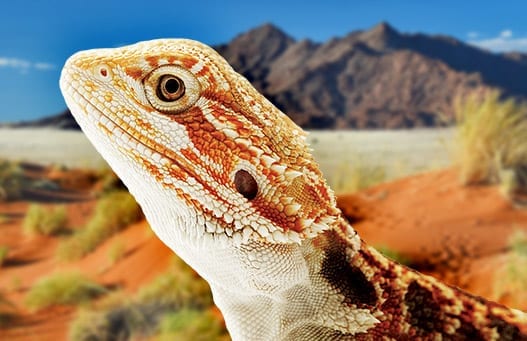The care of Bearded Dragons and other Desert Agamids / Iguanids
Housing
- Glass or Wood vivaria.
- A baby will require a 1m long enclosure to live in.
- Adults need a larger vivarium, at least 1.5m long.
- Must be escape proof.
- Provide internal decor such as a water bowl, branches, hides & plants.
Heating / Temperatures
- All species require a minimum basking temperature of around 34-36C — Desert Iguanas, Chuckwallas and Uromastyx a little higher. with a drop to 20-22C overnight
- Install an overhead heater, with a guard so it maintains a hot and cool end to the vivarium. If a light emmiting heater is used, overnight temperatures should be monitored (Particularly during colder months).
- Always install a thermostat.

Lighting
Zone 3 -4 T5 uvb Lighting should be used.
Substrates
- Beardie Life and Earthmix Arid are popular floor coverings but as with all loose substrates there is a risk of ingestion
- Some keepers prefer newspaper or similar.
- Sphagnum moss can be used in a humid area.
Hygiene
- Spot clean daily taking out faecal, uneaten food etc.
- Change water daily.
- Strip out and change substrates every four weeks.
Humidity (level of moisture in the air)
All species require a dry atmosphere around 40-50%
Diet and Supplements
- Commercially available livefood such as crickets, worms, locusts,
waxworms & cockroaches. Not for Chuckwallas and Uromastyx. - Gut load the livefood with a insect loading mixture.
- Green leafy salad leaves such as water cress, dandelion leaves, curly
kale etc. - Use a reptile multi-vitamin and calcium supplement.
- Feed livefood daily for babies and every other day for adults, veg should be offered daily.
Handling
Babies may go off their food if handled every day. Adults will tolerate more handling, within reason.
Signs of Ill Health
- Thin or skinny
- Sunken looking skin or eyes
- Sores
- Lack of appetite
- Tremors
- Cloudy or dull eyes
- Bloated
- Thin tail
- Lethergy
Possible causes of Ill Health
- Parasites
- Dirty conditions
- Incorrect diet / supplementation
- Incorrect temperature / Humidity control
- Over handling
What to do in case of Ill health
- Keep at optimum temperature
- Seek help from qualified vet
- Keep disturbance to a minimum

Why are some species so similar to look after?
Evolution dictates this; no matter where we are in the world animals will genetically evolve to thrive in a given habitat. This group is a perfect example; Bearded / Rankin Dragons are Agamid species and Desert Iguanas / Crevice lizards are Iguanids but they have managed to fulfil a niche way of life to live in a similar terrain separated by thousands of miles.
Is a Bearded Dragon or similar suitable for Me?
- I am aware of the long life aspect—maybe 10-20 years plus.
- As with all animals I am aware of the risk of salmonella.
- I am aware of the need of a very large enclosure for an adult Bearded Dragon.
Recommended Supplies
- Glass, wood or plastic vivarium — around 1m long for a baby, 1.5m for an adult
- Floor coverings are popular.
- Guarded overhead Heater with thermostat.
- Temperature gauges.
- T5 UVB lighting
- Appropriate calcium/multi-vitamin supplements
- Water and food bowl.
- Hides and climbing decor.
